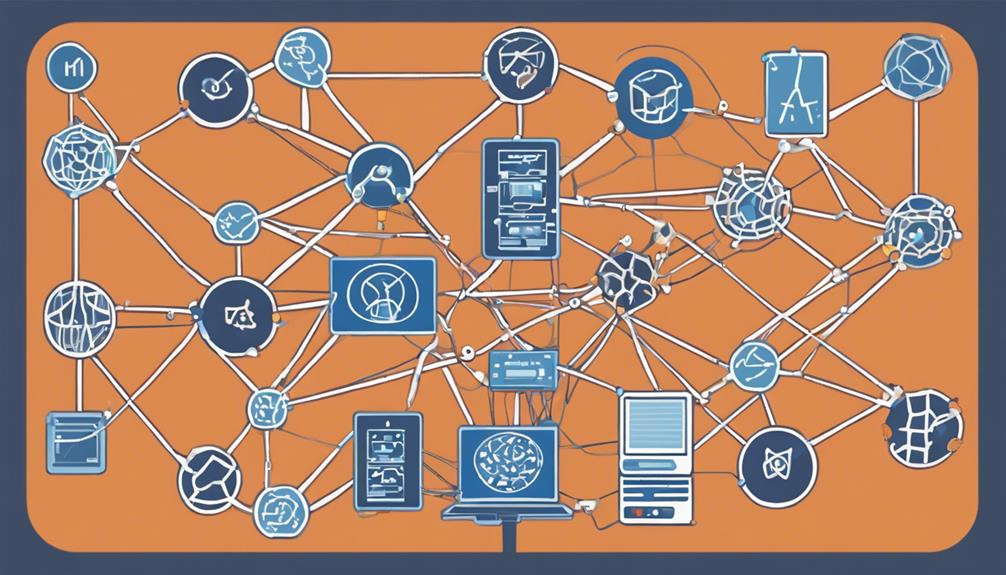When venturing into the challenges of web data mining, the labyrinth of challenges awaits, each more intricate than the last. From navigating the murky waters of data privacy concerns to taming the unruly beast of data overload, the path ahead is fraught with complexities that demand your unwavering attention. As you embark on this journey, be prepared to uncover the nuances of data quality, integration, and security that will shape your understanding of the intricate web data mining landscape and the strategies needed to conquer its formidable obstacles.
Data Privacy Concerns
Data privacy concerns in web data mining revolve around the ethical implications and regulatory compliance involved in collecting and analyzing personal information without user consent. The ethical implications stem from the potential misuse of sensitive data and the infringement upon individuals’ privacy rights. From a legal standpoint, regulatory compliance is a crucial aspect to ensure that data mining practices adhere to laws and guidelines governing data protection.
User consent plays a central role in addressing these concerns, as obtaining explicit permission from individuals before collecting their data is essential for maintaining ethical standards and regulatory compliance. Failure to secure user consent can lead to severe consequences, including legal penalties and reputational damage for organizations involved in web data mining activities.
Data protection measures must be implemented to safeguard the privacy and confidentiality of personal information gathered during web data mining processes. By prioritizing ethical considerations, ensuring regulatory compliance, obtaining user consent, and enhancing data protection protocols, organizations can navigate the complex landscape of data privacy concerns in web data mining effectively.
Ensuring Data Quality
In the realm of web data mining, the quality of data gathered is paramount to the success and reliability of analytical outcomes. Ensuring data quality involves meticulous processes such as data validation and data preprocessing. Data validation focuses on verifying the accuracy and completeness of the collected data. It includes checking for inconsistencies, missing values, and outliers that could skew the analysis results. Through data preprocessing, raw data is refined and transformed into a format that is suitable for mining. This step involves cleaning the data, handling missing values, normalizing data, and removing noise.
Data quality issues can arise from various sources, such as errors in data entry, inconsistencies in data formats, or biases in the data collection process. Addressing these challenges requires attention to detail and the implementation of robust data cleaning and preprocessing techniques. By ensuring that the data used for mining is accurate, consistent, and reliable, analysts can enhance the effectiveness of their data mining efforts and derive meaningful insights from the web data.
Challenges in Data Integration
When tackling the challenges of data integration, you will face complexities stemming from the diverse nature of data sources. These variations in data structures and formats can lead to difficulties in aligning and mapping schemas effectively. Managing schema mapping issues becomes crucial in ensuring a coherent integration process.
Data Sources Complexity
Navigating the intricate landscape of data integration poses a formidable challenge for web data mining practitioners. The complexity of data sources adds another layer of difficulty to the process. Utilizing effective data extraction methods and data preprocessing techniques is essential to handle the diverse formats and structures of data from various sources. Different sources may require specific extraction methods, making the integration process even more challenging.
Furthermore, data interpretation challenges arise due to the vast amount of data collected from different sources. To overcome this, practitioners need to employ advanced data visualization tools to make sense of the data and extract meaningful insights. These tools help in representing complex data in a visual format, making it easier to identify patterns, trends, and anomalies within the integrated datasets.
Schema Mapping Issues
Amidst the myriad challenges encountered in web data mining, one critical aspect that demands meticulous attention is the issue of schema mapping. Schema mapping involves aligning the structures of different databases or data sources to facilitate data integration. One of the key challenges in schema mapping is data transformation, where data from one schema needs to be converted to match the structure of another schema. This process can be complex, especially when dealing with large volumes of data or diverse data types.
To address schema mapping issues, organizations often utilize mapping algorithms. These algorithms help automate the process of matching attributes and entities between different schemas, reducing the manual effort required for schema integration. However, selecting the appropriate mapping algorithm and ensuring its accuracy can be a significant challenge in itself. Additionally, maintaining these mappings over time as schemas evolve can introduce further complexity to the data integration process. In conclusion, effective schema mapping is crucial for successful data integration and requires careful consideration of data transformation processes and mapping algorithms.
Dealing With Data Overload
With the exponential growth of online data, organizations are facing an unprecedented challenge in managing and making sense of the sheer volume of information available. Handling large datasets has become a daunting task as the amount of data generated continues to increase rapidly. Managing information overload requires efficient strategies to extract valuable insights from this vast pool of information.
To tackle the issue of data overload, organizations must implement advanced data mining techniques and tools that can handle the massive amounts of data being generated. This involves utilizing technologies like machine learning algorithms, big data analytics, and artificial intelligence to sift through the data efficiently. By automating the process of data extraction, organizations can streamline the analysis and decision-making processes.
Furthermore, establishing clear objectives and defining specific data mining goals are essential in managing information overload. By focusing on extracting relevant information that aligns with business objectives, organizations can avoid drowning in unnecessary data. Prioritizing data quality over quantity can significantly improve the effectiveness of web data mining efforts in the face of overwhelming volumes of information.
Importance of Data Security
Ensuring robust data security measures is paramount in the realm of web data mining. In this context, encryption methods play a crucial role in safeguarding sensitive information from unauthorized access. By implementing strong encryption techniques, such as AES or RSA, organizations can secure data both in transit and at rest, mitigating the risk of data breaches.
User authentication is another critical aspect of data security in web mining. Implementing multi-factor authentication protocols can ensure that only authorized users can access the data, adding an extra layer of protection against potential threats. Network security is also essential, as it helps in monitoring and controlling incoming and outgoing network traffic to prevent unauthorized access or data leaks.
Data breaches are a significant concern in web data mining, as they can lead to severe consequences such as financial losses and damage to reputation. By prioritizing data security through encryption methods, user authentication, and network security, organizations can minimize the risks associated with data breaches and protect their valuable information from malicious actors.
Strategies for Data Management
When it comes to managing data in web data mining, you need to focus on three key strategies: data storage solutions, data cleansing techniques, and data security measures. Proper data storage solutions ensure that you can efficiently store and access large volumes of data. Data cleansing techniques are essential for maintaining data quality and accuracy, while robust data security measures protect sensitive information from unauthorized access.
Data Storage Solutions
Efficient data storage solutions are crucial for successful web data mining endeavors. When considering data storage solutions for web data mining, utilizing cloud storage and scalable databases are key strategies. Cloud storage offers flexibility, cost-efficiency, and accessibility, allowing you to store vast amounts of data without the need for physical servers. Scalable databases, on the other hand, enable you to expand your storage capacity as your data mining needs grow, ensuring that you can handle increasing amounts of data effectively. By leveraging cloud storage and scalable databases, you can overcome the limitations of traditional storage methods and ensure that your web data mining operations run smoothly. These solutions provide a foundation for managing and organizing the data collected during the mining process, facilitating easier access and analysis. When implementing data storage solutions, prioritizing scalability, accessibility, and cost-effectiveness will set you up for success in your web data mining initiatives.
Data Cleansing Techniques
Data cleansing techniques play a pivotal role in ensuring the quality and reliability of the data used in web data mining. To achieve this, various strategies are employed, such as data normalization methods, which standardize data into a common format for consistency. Data aggregation techniques are utilized to combine and summarize data from multiple sources for comprehensive analysis. Additionally, outlier detection approaches help identify and handle data points that deviate significantly from the norm, ensuring accurate insights. Duplicate record identification is another crucial step in data cleansing, eliminating redundant entries to prevent skewed results.
Implementing these techniques enhances the accuracy and effectiveness of web data mining processes. By cleansing data through normalization, aggregation, outlier detection, and duplicate record identification, organizations can optimize their decision-making based on reliable and high-quality data. Effective data cleansing not only improves the outcomes of data mining activities but also streamlines operations by ensuring that insights are derived from clean and accurate datasets.
Data Security Measures
To maintain the integrity and confidentiality of your data assets in web data mining processes, robust data security measures are essential. Conducting a thorough risk assessment is the first step in identifying potential vulnerabilities and threats to your data. By understanding these risks, you can implement targeted security measures to mitigate them effectively.
Encryption techniques play a pivotal role in safeguarding your data during web data mining operations. Utilizing strong encryption algorithms ensures that your data is protected both in transit and at rest. By encrypting sensitive information, you add an additional layer of security that prevents unauthorized access and data breaches.
Implementing access controls, such as role-based permissions, can limit the exposure of your data to only those who require it for their tasks. Regular monitoring and auditing of data access logs can help detect any suspicious activities promptly, enabling you to take immediate action to prevent data compromise.
Frequently Asked Questions
How Can Web Data Mining Help Businesses Improve Customer Experience?
To enhance customer experience, web data mining can analyze user behavior, preferences, and feedback. This data aids in customer retention by enabling personalized strategies. Implementing insights from web data mining can optimize business processes and improve overall satisfaction levels.
What Are the Ethical Implications of Using Web Data Mining?
When using web data mining, it’s crucial to consider ethical considerations and privacy concerns. Ensuring data is gathered responsibly with user consent and protected from misuse is essential in maintaining trust and integrity in data-driven practices.
Are There Specific Industries That Benefit the Most From Web Data Mining?
In industries like healthcare and finance, data mining enables targeted treatment plans and fraud detection. Retail and marketing sectors leverage it for personalized recommendations and market analysis. Various sectors benefit from web data mining’s insights for strategic decision-making and operational efficiency.
Can Web Data Mining Predict Future Trends Accurately?
When you explore web data mining’s capabilities, keep in mind that trend forecasting accuracy hinges on the quality of data and the algorithms used. Be aware of predictive analytics limitations to make informed decisions.
What Are the Limitations of Web Data Mining in Terms of Scalability?
When it comes to scalability in web data mining, you face data extraction challenges like handling vast amounts of information and data processing limitations such as resource constraints. Balancing these aspects is crucial for efficient mining.



